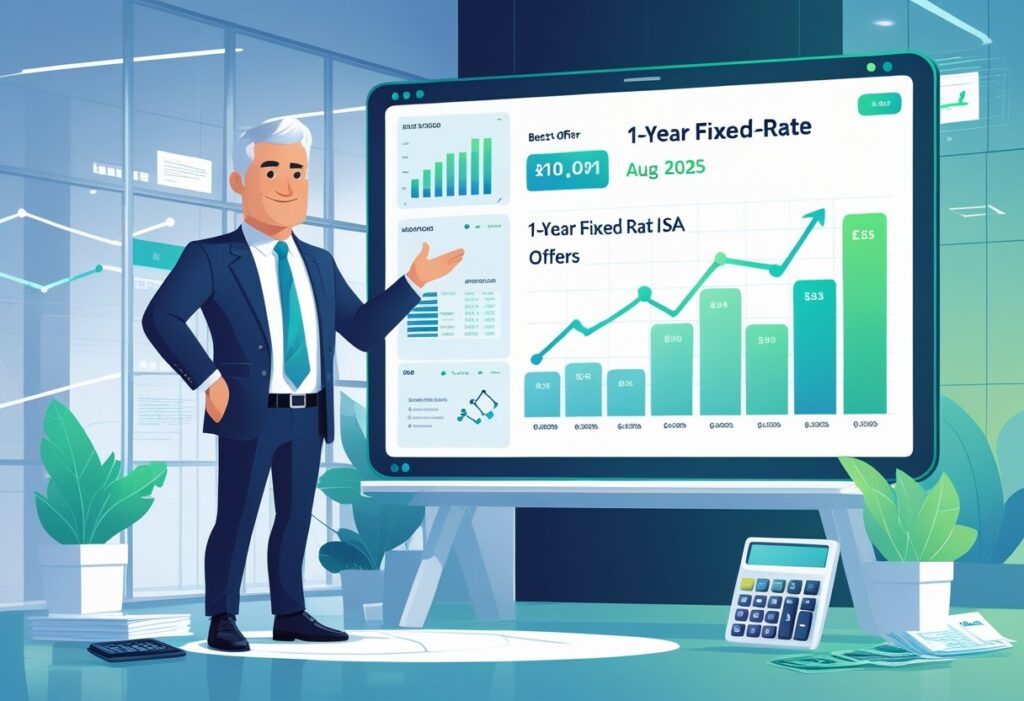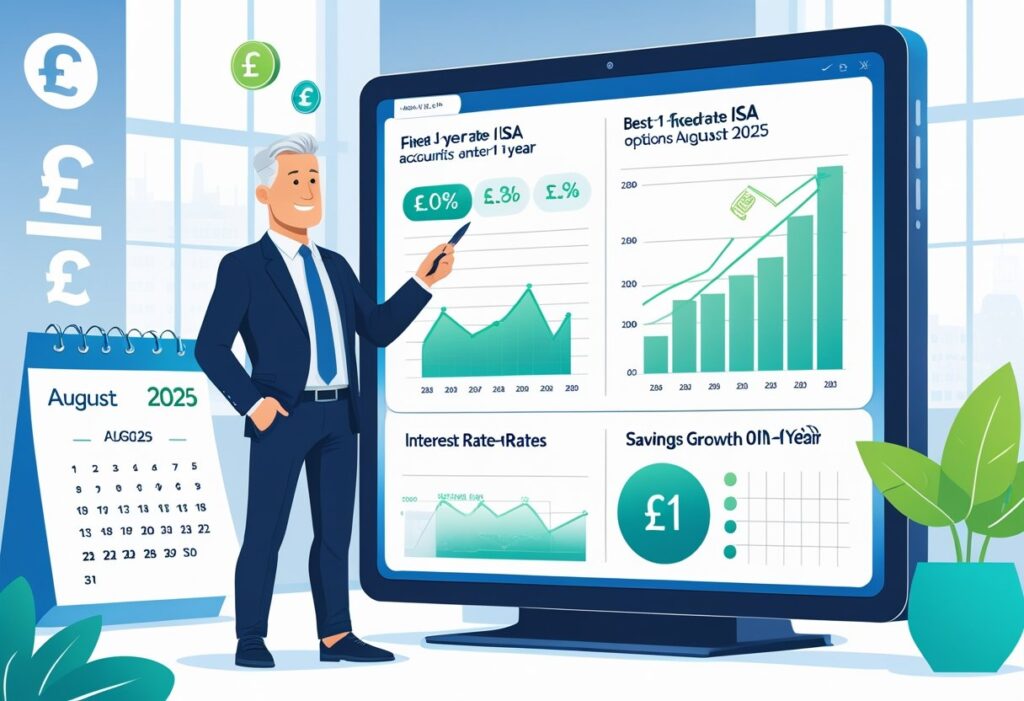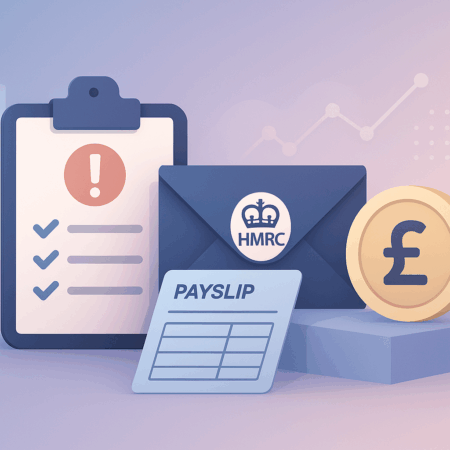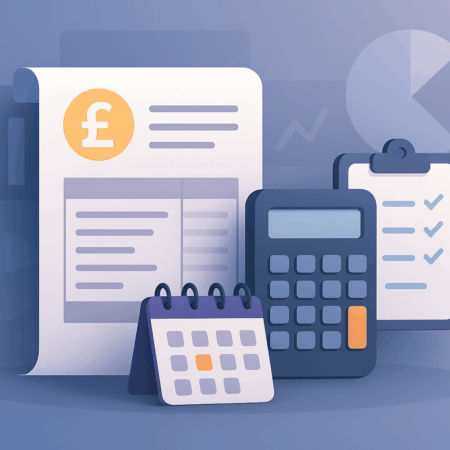Martin Lewis has highlighted the top-performing 1 year fixed-rate Cash ISAs for August 2025, focusing on accounts that lock in a competitive interest rate for the full term. UBL UK currently offers one of the best rates at 4.31% AER, giving savers a guaranteed return without the risk of rate cuts during the year. This makes it a strong option for those who want certainty over their savings growth.

By choosing a 1 year fixed-rate ISA, savers can take advantage of their tax-free allowance while avoiding the volatility of variable rates. Martin’s recommendations are based on stability, clear terms, and competitive returns, making them suitable for anyone who can commit their money for 12 months without withdrawals.
These picks also reflect the current market trend where short-term fixed rates remain appealing compared to some longer-term deals. With the 2025/26 ISA allowance in effect, the right choice now could help maximise savings potential for the year ahead.
Martin Lewis’ Top 1 Year Fixed-Rate ISA Picks for August 2025

Martin Lewis has highlighted several 1-year fixed-rate Cash ISAs in August 2025 that combine competitive interest rates with clear terms. These accounts allow savers to lock in a rate for 12 months, providing certainty on returns during a period of fluctuating savings rates.
Current Leading Providers
The MoneySavingExpert team has identified Castle Trust Bank, Cynergy Bank, and Zopa among the top providers for 1-year fixed-rate Cash ISAs this month.
Castle Trust Bank offers a straightforward online application and a fixed term with no withdrawals. Cynergy Bank provides a similar product with online and app-based account management. Zopa, a newer entrant to the ISA market, has focused on competitive rates and a simple digital sign-up process.
These providers are regulated by the Financial Services Compensation Scheme (FSCS), protecting eligible deposits up to £85,000 per person, per bank. This protection is an important consideration for those placing large sums into a fixed-rate ISA.
Interest Rates and Terms
As of August 2025, the top 1-year fixed-rate Cash ISAs are offering rates of up to 4.31% AER. This is higher than many instant-access Cash ISAs but lower than some longer-term fixed options.
Interest is typically calculated daily and paid either annually at maturity or monthly, depending on the provider. Savers should check whether interest is added to the ISA balance or paid into a separate account.
Withdrawals are usually not allowed during the fixed term. If permitted, they often incur a significant interest penalty, such as the loss of 90 to 120 days’ interest. This makes them best suited for funds that will not be needed within the year.
Eligibility Criteria
Most 1-year fixed-rate Cash ISAs require applicants to be UK residents aged 16 or over. The annual ISA allowance for the 2025/26 tax year is £20,000, which can be placed into one or more types of ISA, including a fixed-rate Cash ISA.
Minimum deposit requirements vary. Castle Trust Bank and Cynergy Bank often require at least £1,000, while Zopa has been known to accept lower minimums, sometimes from £500.
Transfers from other ISAs are generally accepted, but applicants should confirm whether partial transfers are allowed. Identification checks are carried out electronically in most cases, speeding up the account opening process.
How 1 Year Fixed-Rate Cash ISAs Work
A 1-year fixed-rate Cash ISA locks in an interest rate for 12 months, protecting savers from rate cuts during that period. They suit those who can set aside a lump sum without needing to access it before maturity.
Key Features and Benefits
A fixed-rate Cash ISA offers tax-free interest under the ISA allowance, currently £20,000 for the 2025/26 tax year. The rate is fixed for the agreed term, so it will not change even if market rates fall.
Many providers offer competitive rates on 1-year terms, often higher than easy-access ISAs. For example, as of August 2025, top rates are around 4.31% AER.
Interest can be paid monthly or annually, depending on the provider’s terms. This allows savers to choose between regular income or compounding growth.
Because the rate is agreed upfront, savers can calculate exactly how much interest they will earn over the year. This certainty appeals to those seeking predictable returns.
Deposit and Withdrawal Rules
To open a 1-year fixed-rate Cash ISA, savers usually need to make a minimum deposit, which can range from as little as £1 to £2,000 depending on the provider.
Most accounts allow only one initial deposit, though some may permit additional deposits within a short funding window after opening. Once the term starts, further deposits are generally not allowed.
Withdrawals are typically restricted. The money is tied up until the maturity date, so savers should only commit funds they can afford to leave untouched for the full term.
Some providers operate entirely online, while others may offer branch or postal applications. Identification and proof of address are required under standard banking rules.
Early Access Penalties
If a saver needs to withdraw funds before the end of the 12-month term, penalties apply. These usually take the form of an interest loss, such as 90 to 180 days’ interest deducted from the balance.
In some cases, the penalty may exceed the interest earned so far, meaning the saver could get back less than they deposited. This is why early access should be avoided unless absolutely necessary.
Providers may also close the account if early withdrawal is requested, paying the remaining balance after penalties. This ends the fixed rate and forfeits any future interest.
Comparing 1 Year Fixed-Rate ISAs with Other Savings Options

A 1 year fixed-rate Cash ISA locks in an interest rate for 12 months, protecting savers from rate cuts. Other options, such as easy access ISAs or standard savings accounts, offer different trade-offs in terms of flexibility, tax benefits, and returns.
Fixed-Rate ISAs vs. Easy Access ISAs
A fixed-rate Cash ISA offers a guaranteed rate for the full term. This means the bank cannot lower the interest, even if market rates fall. In August 2025, top 1 year fixed-rate ISAs are paying around 4.31%–4.35% AER.
Easy access ISAs allow withdrawals at any time without penalty. Rates are usually lower, with leading accounts offering around 4.6% AER but subject to change. Providers can reduce rates at short notice.
The choice depends on priorities:
- Fixed-rate ISA – secure rate, no rate cuts, but limited or no withdrawals.
- Easy access ISA – full flexibility, but rates can drop.
Those who do not need the money for a year may prefer the stability of a fixed rate. Savers who want to keep funds available for emergencies may value easy access more.
ISAs vs. Standard Savings Accounts
ISAs offer tax-free interest on deposits up to the annual allowance (£20,000 in 2025/26). This benefit is most valuable for savers who exceed their Personal Savings Allowance (£1,000 for basic rate taxpayers).
Standard savings accounts, including fixed-rate bonds, often pay higher rates than equivalent ISAs. For example, a 1 year fixed-rate bond might offer 4.5%–4.8% AER, compared to around 4.3% for an ISA. However, interest from these accounts is taxable once the allowance is used.
| Feature | Cash ISA (1 Year Fixed) | Standard Savings Account (1 Year Fixed) |
|---|---|---|
| Tax treatment | Tax-free interest | Taxable above PSA |
| Typical rate (Aug 2025) | ~4.3% AER | ~4.5–4.8% AER |
| Access to funds | Usually locked in | Usually locked in |
For higher-rate taxpayers or those with large savings, the ISA’s tax advantage can outweigh the slightly lower rate. For smaller balances, a standard account may be more profitable if the PSA is not exceeded.
Maximising Your ISA Allowance in 2025
The ISA allowance for the 2025/26 tax year remains at £20,000, allowing savers to shelter interest from Income Tax. Using the full allowance can be particularly valuable if interest rates stay high, as it locks in more tax-free returns.
Annual Contribution Limits
The ISA allowance applies across all ISA types, including Cash ISAs, Stocks and Shares ISAs, Innovative Finance ISAs, and Lifetime ISAs. An individual can split the allowance between them, but the total must not exceed £20,000 in the tax year ending 5 April 2026.
For example:
| ISA Type | Max Contribution (if using only that ISA) |
|---|---|
| Cash ISA | £20,000 |
| Stocks and Shares ISA | £20,000 |
| Lifetime ISA | £4,000 (counts towards £20,000 total) |
Deposits can be made in lump sums or regular payments. Once the allowance is reached, no further contributions can be made until the next tax year.
Unused allowance does not roll over, so any unused portion is lost at the end of the tax year. This makes timing important, particularly if interest rates may fall.
Transferring Existing ISAs
ISA transfers allow savers to move funds between providers without losing the tax-free status. This can be useful if a better fixed-rate Cash ISA becomes available during the year.
Transfers from previous tax years do not affect the current year’s allowance. However, moving funds from the current year’s ISA must be done in full if switching providers.
The transfer process should always be initiated by the new provider to preserve ISA status. Withdrawing funds manually before redepositing will count towards the annual limit and could result in losing part of the allowance.
Fixed-rate ISAs may have early withdrawal penalties, so checking terms before transferring is essential to avoid reducing returns.
Choosing the Right Fixed-Rate Cash ISA Provider
When selecting a one-year fixed-rate Cash ISA, savers should look beyond the advertised interest rate. The provider’s reliability, account management options, and deposit protection measures can be just as important as the rate itself.
Customer Service and Reputation
A provider’s track record for customer service can affect how easily savers manage their account. Clear communication, efficient application processes, and prompt responses to queries are key factors.
Independent review platforms and consumer forums can help verify a bank or building society’s reputation. For example, some savers prefer established high street names, while others are comfortable with newer digital banks like Zopa, provided feedback is consistently positive.
It is also worth checking how the provider handles account maturity. Some automatically reinvest funds into another fixed term unless instructed otherwise, which could lock savers into a lower rate.
Key checks before applying:
- Availability of online, app, and phone support
- Average call waiting times
- Transparency of terms and conditions
- Existing customer satisfaction ratings
FSCS Protection and Security
In the UK, most fixed-rate Cash ISAs from banks and building societies are covered by the Financial Services Compensation Scheme (FSCS). This protects eligible deposits up to £85,000 per person, per institution.
Savers should confirm that the provider is FSCS-authorised and understand that the limit applies per banking licence, not per brand. For example, two brands under the same licence share the £85,000 protection.
Security of account access is another factor. Providers offering two-factor authentication and secure messaging reduce the risk of unauthorised access.
Before opening an account, confirm:
- FSCS registration on the official FSCS website
- Whether the licence is shared with other brands
- Security measures for online and mobile banking
Other Types of ISAs to Consider
Some ISAs are designed for specific goals such as buying a first home, saving for retirement, or investing for a child’s future. Others allow investment in stocks and shares rather than keeping savings in cash, offering different risk and return profiles.
Lifetime ISAs
A Lifetime ISA (LISA) allows individuals aged 18–39 to save up to £4,000 per tax year. The government adds a 25% bonus on contributions, worth up to £1,000 annually.
Funds can be used to buy a first home worth up to £450,000 or accessed after age 60. Withdrawals for other reasons incur a 25% penalty, which means losing the bonus and some of the original savings.
They can be held as a cash LISA or a stocks and shares LISA. Cash LISAs offer fixed or variable interest, while investment LISAs carry market risk but may offer higher long-term growth.
It’s important to note that the LISA allowance forms part of the overall £20,000 annual ISA limit. This means contributions to a LISA reduce the amount that can be paid into other ISAs in the same tax year.
Junior and Stocks & Shares ISAs
A Junior ISA (JISA) is available to children under 18 and can be opened by a parent or guardian. The annual limit is £9,000 for the 2025/26 tax year.
There are two types: Junior Cash ISAs, which earn interest tax-free, and Junior Stocks and Shares ISAs, which invest in funds, shares, or bonds. Investment returns are not guaranteed and can go down as well as up.
The account is locked until the child turns 18, at which point it converts into a standard ISA. This makes it suitable for long-term savings or investments intended for adulthood.
Stocks and Shares ISAs for adults work in a similar way to the junior version but have a higher annual allowance, up to the full £20,000 ISA limit. These accounts can include shares, funds, investment trusts, and bonds, offering potential for growth alongside the risk of capital loss.









